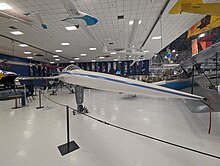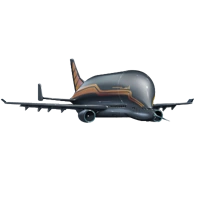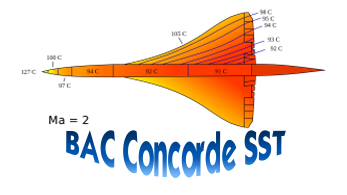Ntechnology demonstration
Baby Boom XB-1
|
|||||||||||||||||
|---|---|---|---|---|---|---|---|---|---|---|---|---|---|---|---|---|---|
.
History Technology demonstrator
Boom XB-1 "Baby Boom"
.svg.png)
The Boom XB-1 "Baby Boom" is a one-third-scale trijet supersonic demonstrator designed by Boom Technology (dba "Boom Supersonic") as part of development of the Boom Overture supersonic transport airliner. Powered by three General Electric J85s, it is planned to maintain Mach 2.2, with over 1,000 nautical miles (1,900 km; 1,200 mi) of range. The XB-1 began taxi tests in December 2022, and conducted its maiden flight on March 22, 2024
The design was unveiled in Denver, Colorado, on November 15, 2016, and it was initially intended to make its first subsonic flight in late 2017, powered by three General Electric CJ610 turbojets (a civilian J85), with subsequent supersonic flight testing at Edwards Air Force Base, California.
Design


The XB-1 Baby Boom is 68 feet (21 m) long with a 17 ft (5.2 m) wingspan and a 13,500-pound (6,100 kg) maximum take-off weight. Powered by three non-after-burning (“dry”) J85-15 engines with variable geometry inlets and exhaust, the prototype should be able to sustain Mach 2.2 with more than 1,000 nmi (1,900 km; 1,200 mi) of range. As a technology demonstrator for the Boom Overture, the XB-1's trijet configuration matched that of the Overture. In 2022, the Overture was redesigned to a quadjet configuration. The XB-1 retains the original trijet configuration.
Photo Gallery
Technology demonstrator
Boom XB-1 "Baby Boom"


Technology demonstrator
Boom XB-1 "Baby Boom"
General Info 1
-
-
- Crew: 1 (Design allows for a second seat)
- Length: 68 ft (21 m)
- Wingspan: 17 ft (5.2 m)
-
General Info 2
-
-
- Height: 17 ft 0 in (5.2 m)
- Max takeoff weight: (6,123 kg)
- Powerplant: 3 × General Electric J85-15 turbojet, 4,300 lbf (19 kN) thrust each
-
General Info 3
- Maximum speed: Mach 2.2
- Range: 1,000 nmi (1,200 mi, 1,900 km)
.
Links to Youtube & Others
The XB-1 is constructed of lightweight composites, titanium and A286. Materials for the hot leading edges and 307 °F (153 °C) nose, and epoxy materials for cooler parts, are provided by Dutch TenCate Advanced Composites, high-temperature materials supplier for the SpaceX Falcon 9.[8] The airframe will be primarily intermediate-modulus carbon fiber/epoxy, with high-modulus fibers for the wing spar caps and bismaleimide pre-preg for the high-temperature leading edges and ribs
Technology
Boom XB-1 "Baby Boom"
The rear section of fuselage containing the engines is made from 90% titanium and 10% A286 stainless steel alloys
Youtube Link
The rear section of fuselage containing the engines is made from 90% titanium and 10% A286 stainless steel alloys














